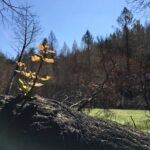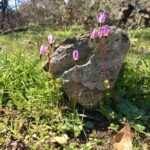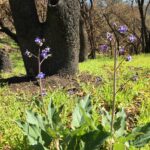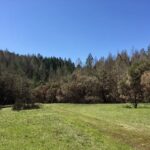March 24, 2021
Posted in: News Articles
Post-fire renewal on Saddle Mountain Open Space Preserve
An update from Monica Delmartini, Ag + Open Space Stewardship Specialist
With spring officially just around the corner, we’re seeing some beautiful signs of post-fire renewal at our Saddle Mountain Open Space Preserve, which burned in the Glass Fire last September. The fire’s effects across the Preserve were patchy, with higher severity areas confined to two ridgelines and the dry, easternmost portion of the preserve, which burned during the initial wind event on the first night of the fire. Elsewhere, the fire primarily moved through the Preserve as a ground fire, consuming downed, woody debris on the forest floor and killing small Douglas-fir saplings that had begun crowding oak woodland and other hardwood and redwood forest areas. While the fire left patches of dead Douglas-fir in some areas of the Preserve, in many places the fire only lightly touched the landscape.
Approximately five months after the fire, we’re seeing lush new growth across the Preserve’s grasslands, new leaves on partially scorched oaks, vigorously growing bracken, maidenhair, and licorice fern, and record numbers of native shooting stars and Fremont’s star lily (also known as ‘death camas’) along with the usual early-spring wildflower cohort – hound’s tongue, milk maids, buttercups, and others. As expected, chaparral shrubs like manzanita, ceanothus, chemise, and coyote brush as well as hardwood trees like madrone and bay laurel are re-sprouting from their bases and should regrow quickly. Burned trees provide excellent habitat for woodpeckers and other bird species, and Ag + Open Space staff have been hearing lots of pileated woodpeckers calling within the Preserve’s forests in recent weeks.
While the major wildfires our region has experienced in recent years have been terribly and tragically impactful for the community, it can be reassuring to see wild places like Saddle Mountain and other local, protected lands quickly respond to and even benefit from the return of fire to the land. The patchy nature of the fire’s effects across Saddle Mountain will help support an enhanced diversity of forest types, plant species, and wildlife habitats. The fire provided a burst of soil nutrients to help plants thrive, and stimulated long-dormant seeds to grow and thereby renew certain fire-dependent and fire-following species’ presence on the land.
In the wake of the fire, we’ve had work to do to repair fire suppression damage, remove burned structure debris, improve a stream crossing at a burned culvert location, and address a large number of hazardous trees along roadways. Most of this work is complete, with the hazard tree work underway now. In addition, we’re continuing to move forward with the forest stewardship and prescribed fire planning that we’d initiated prior to the Glass Fire.
With the help of a consulting Registered Professional Forester and ongoing coordination with Cal Fire, we’ve just finalized thinning prescriptions for shaded fuel breaks that will allow for safer access and strategically reduced fuels along roads that could be used both in future wildfire suppression scenarios and for future prescribed burn control lines. We’re working with another Registered Professional Forester on a broader forest restoration thinning plan to reduce hazardous fuels and improve forest health and biodiversity across the Preserve’s forests and woodlands. With help from a Prescribed Fire Specialist we’re just wrapping up a prescribed fire plan for about twenty potential forest prescribed burn units; these will be included with a number of grassland units in a Vegetation Management Program contract with Cal Fire. In order to take advantage of the unique opportunities presented by the post-fire environment, cultural resource and botanical survey work is underway, and we’re strategically addressing some problem invasive species within the Preserve’s grasslands.
The Saddle Mountain Open Space Preserve is part of the Wappo People’s ancestral homeland, and we recognize that their active stewardship shaped and nurtured the plant communities and habitats in the region for millennia. It’s our hope that during this time that our agency has the responsibility for caring for Saddle Mountain, we can promote and restore Indigenous access to and stewardship of the Preserve while ensuring that the projects we plan and undertake for the health of the land are consistent with traditional practices to the greatest extent possible. To this end, we’re working with Wappo Tribal representative Clint McKay on the development of our forest stewardship and prescribed fire planning for the Preserve. Through this coordination and dialogue, we hope to create opportunities for the Wappo People and Tribal youth to be directly involved with land stewardship and restoration at Saddle Mountain.
In addition, we’re looking forward to welcoming the return of educational outings with a fire ecology walk in partnership with Sonoma Ecology Center in May, as well as re-opening the Preserve to our volunteer patrollers this spring. If you are interested in becoming a volunteer patroller or participating in any upcoming volunteer work days at Saddle Mountain, please contact Monica Delmartini at Monica.Delmartini@sonoma-county.org.



